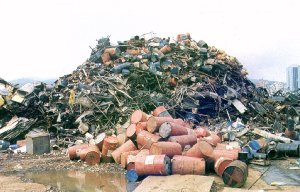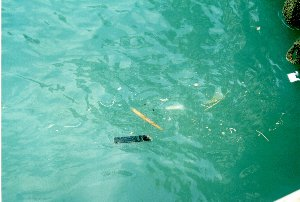Ecology of Hong Kong
|
|
The ecology of Hong Kong is mostly affected by the results of climatic changes. Hong Kong's climate is seasonal due to alternating wind direction between winter and summer.
Hong Kong is geologically stable for millions of years, flora and fauna in Hong Kong are altered by climatic change, sea level alternation and human impact.
| Contents |
Climate
Main article: Climate of Hong Kong
Hong Kong's climate is subtropical but half of a year is temperate. The territory is situated on the South of the tropic of Cancer which is equal to Hawaii in latitude. In winter, strong and cold wind generates from the North to Hong Kong; in summer, the wind reverses in direction and bring the warm and humid air from the South. This climate would support tropical rainforest.
Land
The total land area of Hong Kong is 1,076 square kilometers, but about 75% of it is open countryside, which contains more than 2600 species of vascular plants, about 450 species of birds, about 200 species of buttlerflies, about 100 species of dragonflies, 40 species of mammals, 80 species of reptiles and more than 20 species of amphibians.
Examples of Ecosystem in Hong Kong
Mangroves
Mangroves are habitats of enclosed intertidal mud flats with wave action greatly reduced and influx of freshwater hit. Popular mangrove habitats in Hong Kong are located along Deep Bay, such as Pak Nai and Tsim Bei Tsui, where salinity is very low under the influence of freshwater from the Pearl River, and along some mud flats where salinity is lowered by surrounding streams, such as Three Fathoms Cove and Ting Kok. Trees living in this habitat are called mangrove trees. During high tides, parts of the trunks of these trees are immersed while they are completely exposed to sunlight during low tides. Plants living in mangroves will face difficulties in gaining strong anchorage in the soft substratum, obtaining enough oxygen from the anoxic mud and also need to tolerate fluctuating salinity and desiccation stress during low tides. Organisms living in this habitat have, therefore, adaptive features enabling them to survive in such a stressful environment.
The following are the sites of Rocky Shores in Hong Kong:
- Hoi Ha
- Lung Kwu Tan
- Butterfly Beach
- Silverstrand Beach
- Deep Water Bay
- Middle Bay
- South Bay
- Stanley
- Turtle Cove
- Tai Tam
Rocky Shores
Rocky shore is the transition from a terrestrial to a marine environment. The habitat will expose to this two physical conditions. In a day, the shores are covered with sea water when it is high tide; the shores are exposed to the air directly when it is low tide. Animals and plants have to tolerate to these two totally different conditions. The vertical dimension of the rocky shore is the environmental gradient: the upper parts are out of water most of the time while the lower parts are under water most of their life. Animal in the upper parts have to be adaptive to survive in the long periods exposure of high temperatures and desiccating conditions while those in the lower parts are exposed to long periods of immersion and predation of marine species. The tidal range of Hong Kong is about 2.5 meters and the distribution of species is situated into this area have to be tolerate for both environment within a day or hours. Species which have adapted to these different conditions are described as specialized to successfully exploit narrow vertical zones on the rocky shore.
The species inhabiting Hong Kong rocky shores varies in accordance with the exposure to the wave action from the sea. The sessile filter feeding organisms inhabit in the wave exposed shores. They are able to attach on the rock surface and remove food particles exist in the turbulent water; while the mobile herbivores and carnivores inhabit in the sheltered shores. The varieties of the organisms also different from seasons, especially in Hong Kong where oceanic currents change with season: very few erect foliose macro-algae are found in summer because they may suffer from the burning heat; a lot of foliose algae are found on the shores in winter.
The following are the sites of Rocky Shores in Hong Kong:
Streams
Freshwater habitats have two types: lentic water, such as lakes, ponds, ditches, and lotic water, such as rivers, streams. Stream is an example of a lotic habitat.
There are three main factors to differentiate the habitats: variability of current, amount of detritus and variable oxygen content. These factors contribute to make the animals adapted in different ways. They have to attach themselves to the surfaces, become detritivores predominate and have a mechanism for obtaining maximum oxygen supply.
The followings are the sites of Streams in Hong Kong:
Sandy Shores
Depend on the strength of wave action received, Sandy shores can be divided into two major habitat: Exposed sandy shores and Protected sandy shores. Exposed sandy shores receive strong wave action which makes the sand substratum having large particles and being highly mobile. Protected sandy shores can be found in sheltered positions where the weaker wave action there results in more stable substratum with relatively less disturbance comparing to exposed sandy shores and the particle size is smaller. The more stable substratum makes the protected sandy shores compose of more varieties of species.
A sandy shore is three-dimensional. Life in sandy shores is distributed according to the ecological gradients: vertical, horizontal and depth gradients. Vertical gradients are created by the tidal cycles. Sand in the lower-intertidal zone only dries out at the surface during low tides, while in the upper-intertidal zone sand may be dried for longer periods and to a greater depth as this area exposed to air more, uncover by tides.
Horizontal gradients are the result of local topography and oceanography. Depth gradients within a sandy shore are the result of oxygen availability and it depends on large extent on the particle size of sand. Oxygen availability decreases with increasing depth. So the action of anaerobic bacteria makes the sand turn black in the deeper region. As smaller sand grain sizes are associated with lower intertidal areas, it is expected that the black anaerobic layer occur at a shallower depth than in upper intertidal regions where larger grain sizes predominate. Dry sand is aerated so it does not support the anaerobic layer. Organisms on sandy shores can live both on the surface of the substratum and also within the sand by burrowing.
There are three groups of fauna in the sandy shores: Surface dwellers, burrowers, temporary burrowers. Surface dwellers are usually scavengers such as crustaceans. They feed on macroscopic detritus or particles sifted from the sand. Borrowers include both shallow and deep burrowers. Most of them are bivalves and worms. Temporary burrowers can be surface dwellers or burrowers during different phases of the tidal cycle.
Living on the sand surface allows animals to move about easily to survive: to find food or mate. Every coin has two sides. It also has disadvantages. The shore is exposed to air and strong solar radiation at low tide. Organisms living there must possess mechanism to prevent water loss and solar radiation. The solution can be living within the sand. They can get the benefit of protection from wave action, predation and desiccation during low tides. But the challenges are having difficulties in finding food and gaining enough oxygen as well as mating. Survival for the fittest depends largely on adaptation.
The following are the site of Sandy Shores in Hong Kong:
Pollution Problems
In 1989, the Hong Kong government suddenly realised that Hong Kong was in danger of becoming a vast, densely populated city. Due to the uncontrollable business and economic growth, the water, waste and air pollution cause an adverse effect on the balance of ecology in Hong Kong.
As the business expands, new infrastructure and construction will be established. But demolition of the old ones needs to be conducted. Enormous amount of trash and solid waste are brought to the new landfalls. It causes serious land and air pollution on the landfalls.
Factories, farms and restaurants in the New Territories dump out large amounts of sewage or even untreated waste into the streams and the sea. It makes the New Territories streams are 'no better than open sewers'. This severe damage is irreversible and the creatures in the sea are the direct victims of the capitalized city’s effort.
The pink dolphin is one of the victims. Under the threat from chemical pollution, increased sea traffic and the destruction of much of the natural shoreline for land reclamation. The number of pink dolphin is dramatically declined as the city continues to improve.
The nature reserve and birds in Mai Po Marsh are the other victims. They are threatened by the pig sewage flooding as well as the increased pollution from Shenzhen. The bird sanctuaries in the wetlands around Mai Po are forced to leave due to the government’s plan to build huge residential housing estates in the New Territories. And the nature environment around Mai Po is changing – no longer a perfect heaven for the birds.
The oyster farms have been throttled by a mixture of pollution and competition from cheaper oyster cultivation across the border in China. Air pollution is another serious problem. Smoke-belching factories, ceaseless construction and large numbers of diesel vehicles have made for dangerous levels of particulate matter and nitrogen dioxide. Not only the flora and fauna are affected but also human being. Cases of asthma and bronchial infections have soared in recent years, and doctors place the blame squarely on poor air quality.
The Environmental Protection Department in Hong Kong is established for long to provide remedies to solve the pollution problem. But it remains to be seen whether the Hong Kong citizens will cooperate to better improve the environmental condition in Hong Kong.
See also
- Geography of Hong Kong
- Hong Kong Country Parks & Special Areas
- Environment of mainland China
- Hong Kong-Zhuhai-Macau Bridge
- List of protected species in Hong Kong
- List of species native to Hong Kong
External links
- The World Wildlife Fund (WWF) in Hong Kong (http://www.wwf.org.hk/chi/index.html)
- Environmental Protection Department (http://www.epd.gov.hk/epd/eindex.html)
- HKNature.net (http://www.hknature.net)
- HK-Ecosite (http://www.hk-ecosite.com/vote/)


